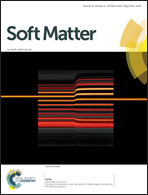From helical supramolecular arrays to gel-forming networks: lattice restructuring and aggregation control in peptide-based sulfamides to integrate new functional attributes†
Abstract
While supramolecular organisation is central to both crystallization and gelation, the latter is more complex considering its dynamic nature and multifactorial dependence. This makes the rational design of gelators an extremely difficult task. In this report, the assembly preference of a group of peptide-based sulfamides was modulated by making them part of an acid–amine two-component system to drive the tendency from crystallization to gelation. Here, the peptide core directed the assembly while the long-chain amines, introduced through salt-bridges, promoted layering and anisotropic development of primary aggregates. This proved to be very successful, leading to gelation of a number of solvents. Apart from this, it was possible to fine-tune their aggregation using an amphiphilic polymer like F-127 as an additive to get honey-comb-like 3D molecular architectures. These gels also proved to be excellent matrices for entrapping silver nanoparticles with superior emissive properties.



 Please wait while we load your content...
Please wait while we load your content...